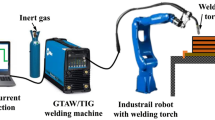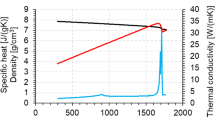Abstract
Wire arc additive manufacturing (WAAM) appears as one of the most promising technologies due to its capacity to process all types of materials used in welding, its high production rate, and capacity to process large geometries of particular interest in the aeronautical industry. Since this technology is still under investigation, it is important to determine the efficiency of the process; in this sense, the melting efficiency stands out not only as a parameter of interest in energy terms but also as a measure of the stability of the process. For calculating melting efficiency, it is necessary to use tailored colorimeters or apply models requiring specific dimensions that involve destructive testing. For this reason, in the development of this work, the melting efficiency is evaluated through machine learning algorithms. Processing parameters such as wire diameter, wire feed speed, travel speed, and net power are used to determine melting efficiency. In addition, a simplified analytical model was developed to compare the results. The average melting efficiency analytically calculated was 44.56 ± 5.48%, while the predicted value reaches a comparable value of 44.32 ± 4.79% obtained with the Gaussian process regressor, which shows the highest accuracy. Moreover, the known relationship with travel speed was verified.









Similar content being viewed by others
Data availability
The dataset and the source code are available at https://github.com/GermanOmar/Melting/blob/master/MeltingEff_WAAM.ipynb
References
Rinaldi M, Ghidini T, Cecchini F, Brandao A, Nanni F (2018) Additive layer manufacturing of poly (ether ether ketone) via FDM. Compos Part B Eng 145:162–172
Mycroft W, Katzman M, Tammas-Williams S, Hernandez-Nava E, Panoutsos G, Todd I, Kadirkamanathan V (2020) A data-driven approach for predicting printability in metal additive manufacturing processes. J Intell Manuf
Li N, Huang S, Zhang G, Qin R, Liu W, Xiong H, Shi G, Blackburn J (2019) Progress in additive manufacturing on new materials: a review. J Mater Sci Technol 35(2):242–269
Karmuhilan M, Sood AK (2018) Intelligent process model for bead geometry prediction in WAAM. Mater Today Proc 5(11):24005–24013
Li JLZ, Alkahari MR, Rosli NAB, Hasan R, Sudin MN, Ramli FR (2019) Review of wire arc additive manufacturing for 3d metal printing. Int J Autom Technol 13(3):346–353
Liu J, Xu Y, Ge Y, Hou Z, Chen S (2020) Wire and arc additive manufacturing of metal components: a review of recent research developments. Int J Adv Manuf Technol 111(1–2):149–198
Xiong J, Yin Z, Zhang W (2016) Closed-loop control of variable layer width for thin-walled parts in wire and arc additive manufacturing. J Mater Process Technol 233:100–106
Fuerschbach PW, Knorovsky AG (1991) A study of melting efficiency in plasma - Desconhecido.pdf. Weld Res Suppl 287–297
Andani MT, Dehghani R, Karamooz-Ravari MR, Mirzaeifar R, Ni J (2018) A study on the effect of energy input on spatter particles creation during selective laser melting process. Addit Manuf 20:33–43
Fotovvati B, Wayne SF, Lewis G, Asadi E (2018) A review on melt-pool characteristics in laser welding of metals. Adv Mater Sci Eng 2018
Stenbacka N, Choquet I, Hurtig K (2012) Review of arc efficiency values for gas tungsten arc welding. IIW Comm. IV-XII-SG212, Intermed. Meet. BAM, Berlin, Ger. 18–20 April. 2012, pp 1–21
American Welding Society (2001) Welding Handbook, vol 1
Sequeira-Almeida PM (2012) Process control and development in wire and arc additive manufacturing. Cranfield University, PhD Dissertation
Wells AA (1952) Heat flow in welding. Weld J 263s-267s
Okada A (1977) Application of melting efficiency in welding and its problems. Yosetsu Gakkai Shi/Journal Japan Weld Soc 46(2):53–61
Mezrag B, Deschaux Beaume F, Rouquette S, Benachour M (2018) Indirect approaches for estimating the efficiency of the cold metal transfer welding process. Sci Technol Weld Join 23(6):508–519
Cambon C, Rouquette S, Bendaoud I, Bordreuil C, Wimpory R, Soulie F (2020) Thermo-mechanical simulation of overlaid layers made with wire + arc additive manufacturing and GMAW-cold metal transfer. Weld World 64(8):1427–1435
Pepe N, Egerland S, Colegrove PA, Yapp D, Leonhartsberger A, Scotti A (2011) Measuring the process efficiency of controlled gas metal arc welding processes. Sci Technol Weld Join 16(5):412–417
Selvi S, Vishvaksenan A, Rajasekar E (2018) Cold metal transfer (CMT) technology - an overview. Def Technol 14(1):28–44
Gianey HK, Choudhary R (2018) Comprehensive review on supervised machine learning algorithms. Proc. - 2017 Int. Conf. Mach. Learn. Data Sci. MLDS 2017, vol 2018-Janua, pp 38–43
Kostopoulos G, Karlos S, Kotsiantis S, Ragos O (2018) Semi-supervised regression: a recent review. J Intell Fuzzy Syst 35(2):1483–1500
Rodrigues TA, Duarte V, Miranda RM, Santos TG, Oliveira JP (2019) Current status and perspectives on wire and arc additive manufacturing (WAAM). Materials (Basel) 12(7)
Jin W, Zhang C, Jin S, Tian Y, Wellmann D, Liu W (2020) Wire arc additive manufacturing of stainless steels: a review. Appl Sci
DebRoy T, Mukherjee T, Wei HL, Elmer JW, Milewski JO (2021) Metallurgy, mechanistic models and machine learning in metal printing. Nat Rev Mater 6(1):48–68
Dinovitzer M, Chen X, Laliberte J, Huang X, Frei H (2019) Effect of wire and arc additive manufacturing (WAAM) process parameters on bead geometry and microstructure. Addit Manuf 26:138–146
Dhinakaran V, Ajith J, Fahmidha AFY, Jagadeesha T, Sathish T, Stalin B (2020) Wire arc additive manufacturing (WAAM) process of nickel based superalloys-A review. Mater Today Proc 21:920–925
Thapliyal S (2019) Challenges associated with the wire arc additive manufacturing (WAAM) of aluminum alloys. Mater Res Express 6(11)
Huang J, Guan Z, Yu S, Yu X, Yuan W, Li N, Fan D (2020) A 3D dynamic analysis of different depositing processes used in wire arc additive manufacturing. Mater Today Commun 24:101255
Nguyen L, Buhl J, Bambach M (2020) Continuous Eulerian tool path strategies for wire-arc additive manufacturing of rib-web structures with machine-learning-based adaptive void filling. Addit Manuf 35:101265
Ding D, Pan Z, Cuiuri D, Li H, Van Duin S, Larkin N (2016) Bead modelling and implementation of adaptive MAT path in wire and arc additive manufacturing. Robot Comput Integr Manuf 39:32–42
Ríos S, Colegrove PA, Martina F, Williams SW (2018) Analytical process model for wire + arc additive manufacturing. Addit Manuf 21:651–657
Li Y, Sun Y, Han Q, Zhang G, Horváth I (2018) Enhanced beads overlapping model for wire and arc additive manufacturing of multi-layer multi-bead metallic parts. J Mater Process Technol 252:838–848
Deng J, Xu Y, Zuo Z, Hou Z, Chen S (2019) Bead geometry prediction for multi-layer and multi-bead wire and arc additive manufacturing based on XGBoost. 125–135
Barrionuevo GO, Ríos S, Williams SW, Ramos-Grez JA (2021) Comparative evaluation of machine learning regressors for the layer geometry prediction in wire arc additive manufacturing. In 12th International Conference on Mechanical and Intelligent Manufacturing Technologies, pp 186–190
Xia C, Pan Z, Polden J, Li H, Xu Y, Chen S (2021) Modelling and prediction of surface roughness in wire arc additive manufacturing using machine learning. J Intell Manuf
Ikeuchi D, Vargas-Uscategui A, Wu X, King PC (2021) Data-efficient neural network for track profile modelling in cold spray additive manufacturing. Appl Sci 11(4):1–12
Chen Z, Wang B, Gorban AN (2020) Multivariate Gaussian and Student-t process regression for multi-output prediction. Neural Comput Appl 32(8):3005–3028
Baturynska I, Martinsen K (2020) Prediction of geometry deviations in additive manufactured parts: comparison of linear regression with machine learning algorithms. J Intell Manuf
Goodfellow I, Bengio Y, Courville A (2016) Deep learning adaptive computation and machine learning. vol 1
Prieditis A, Sapp S (2013) Lazy overfitting control. Lect Notes Comput Sci (including Subser Lect Notes Artif Intell Lect Notes Bioinformatics), vol 7988 LNAI, pp 481–491
Barrionuevo G, Ramos-Grez J, Walczak M, Betancourt C (2021) Comparative evaluation of supervised machine learning algorithms in the prediction of the relative density of 316L stainless steel fabricated by selective laser melting. Int J Adv Manuf Technol
DuPont JN, Marder AR (1995) Thermal efficiency of arc welding processes. Weld. J (Miami, Fla) 74(12):406
Obidigbo C, Tatman EP, Gockel J (2019) Processing parameter and transient effects on melt pool geometry in additive manufacturing of Invar 36. Int J Adv Manuf Technol 104(5–8):3139–3146
Funding
This work was supported by SENESCYT grant number ARSEQ-BEC-000329–2017, the Research Center for Nanotechnology and Advanced Materials (CIEN-UC), ANID FONDECYT grant number 1201068 project, and by the WAAM-Mat research program of Cranfield University.
Author information
Authors and Affiliations
Contributions
Germán O. Barrionuevo: conceptualization, methodology, data curation, writing–original draft preparation. P. M. Sequeira-Almeida: methodology, investigation, formal analysis. Sergio Ríos: formal analysis, validation, supervision, writing–review and editing. Jorge Ramos-Grez: supervision, writing–reviewing and editing. Stewart Williams: funding acquisition, writing–reviewing and editing.
Corresponding author
Ethics declarations
Ethics approval
Not applicable.
Consent for publication
All listed authors approve to publish.
Conflict of interest
The authors declare no competing interests.
Additional information
Publisher's Note
Springer Nature remains neutral with regard to jurisdictional claims in published maps and institutional affiliations.
Rights and permissions
About this article
Cite this article
Barrionuevo, G.O., Sequeira-Almeida, P.M., Ríos, S. et al. A machine learning approach for the prediction of melting efficiency in wire arc additive manufacturing. Int J Adv Manuf Technol 120, 3123–3133 (2022). https://doi.org/10.1007/s00170-022-08966-y
Received:
Accepted:
Published:
Issue Date:
DOI: https://doi.org/10.1007/s00170-022-08966-y




